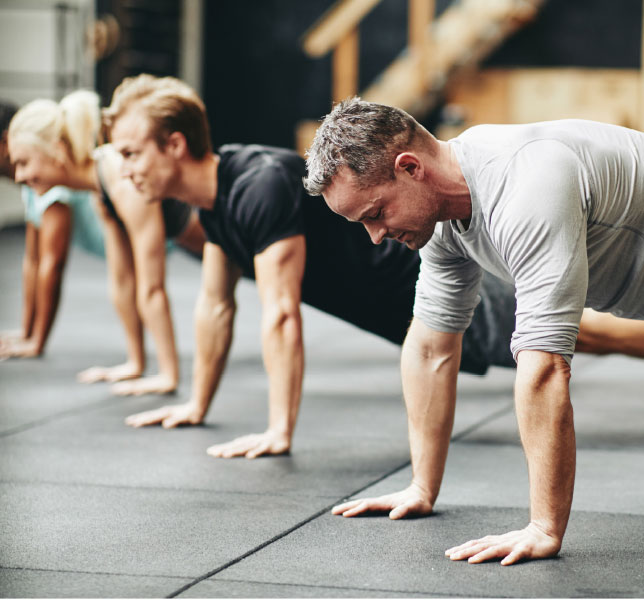
Words Kaisha Scofield
CrossFit is a community experience
A new start can be exciting. The first thing many of us do after welcoming the new year is take on acts of self-improvement.
We vow to be a healthier, fitter and better version of ourselves. We are far more likely to start a new diet, workout program or lifestyle change at the beginning of the year because there is a sense of rebirth and new beginnings; the possibilities seem endless. The trouble is, impulsive lifestyle changes almost always fail. This is due, in part, to the fact that decisions to better ourselves are often made in reaction to overindulgence or the feeling that we don’t measure up, and the guilt and self-judgement that result. But motivation to make changes, when triggered by negative feelings about ourselves and our past actions, rarely enacts long-term, positive change.
Besides being motivated by negative feelings, another self-improvement pitfall is that acting on promised changes often relies on internal motivation. This can be challenging because we are put in charge of our own accountability. Some people have concrete goals and make concrete plans that push them to the gym every day after work, or wake them up early in the morning to meditate.
But many of us, most of us, struggle to start new activities and form new routines by willpower alone. Starting a new workout or wellness routine without external accountability and support, without proper guidance and more than a bit of enthusiasm, can be confusing and lonely. Humans are social creatures, and we are far more likely to succeed if we are surrounded by like-minded people.
Our innate desire to be held accountable, supported and encouraged has recently led to an evolution in self-improvement. Many of the new activities gaining in popularity are centred around the idea of not only getting healthy but getting healthy together, in a community. One of the most popular and effective training programs that has wholly and completely embraced the community focus is CrossFit.
CrossFit is, in essence, a collection of intense and varied activities that are almost guaranteed to leave you in a sweaty heap on the floor. Forming a sweaty heap may not be something you imagine wanting to do in a room with 20 other people, but the CrossFit model may pleasantly surprise you. Its success and its appeal are as much about building relationships and joining a community as they are about the health benefits of intense and varied exercise.
I met up with the owners of CrossFit LoLo, Adam Davidson and Kelsey Goodwin. One of the first things you notice about them is that they are clearly very good at the exercise part of their craft. They are a strong, healthy and powerful-looking pair. But after talking with them for a few minutes, what outshines even the physical evidence of their commitment to health is their unwavering commitment to making the experiences at their gym transformative beyond fitness. Yes, at CFLoLo you will lift heavy things, but you’ll also make gains that can’t be measured by body fat percentage or squat counts.
When asked what they envision for a fitness community, Adam speaks passionately about the possibilities of gyms forming communities centred around shared goals; not only fitness goals but goals that encompass holistic integrity and well-being, because, in his words, “When we see a health-minded community, we see that trickle into the businesses, families, the overall creativity of the community. It isn’t about fitness at all, it’s really about relationships with what we do in our lives, making them better.”
So maybe instead of self-improvement by sheer force of will, instead of generating new plans and goals out of guilt or disappointment, we should join a community. We should become part of a place and a practice where just showing up, participating and being present are the best measures of success. By approaching health and wellness as a group, getting involved and sweating together, we can make changes and form connections that extend beyond the gym and into all aspects of our lives.
HYDRATION
It may surprise you, but water is the most common nutritional deficiency and arguably the easiest to fix. Many of the minor ailments we face day to day, like fatigue, irritability, brain fog, cravings, cramps and headaches, can all be cured simply by drinking more water. It may sound too simple to be true, but the vast majority of us are constantly dehydrated and low in electrolytes. For those of us engaging in sweaty activities, this is even more crucial. More severe dehydration can cause migraines, joint pain, back pain, heartburn and constipation.
So how can we be sure that we’re getting enough water? A simple tool is to divide your body weight, measured in pounds, in half. The result is the minimum number of ounces you should be drinking each day. If you are looking to add electrolytes to your water, which is extra important if you are engaging in strenuous exercise, look for electrolyte powders or tabs that do not have added sugar.
Avoid energy drinks, sports drinks, or juice, which will spike your blood sugar levels. Don’t have electrolytes handy? Simply add a pinch of sea salt to your water — if you can taste the salt, you’ve added too much — and you’re good to go

 Taste of LA
Taste of LA